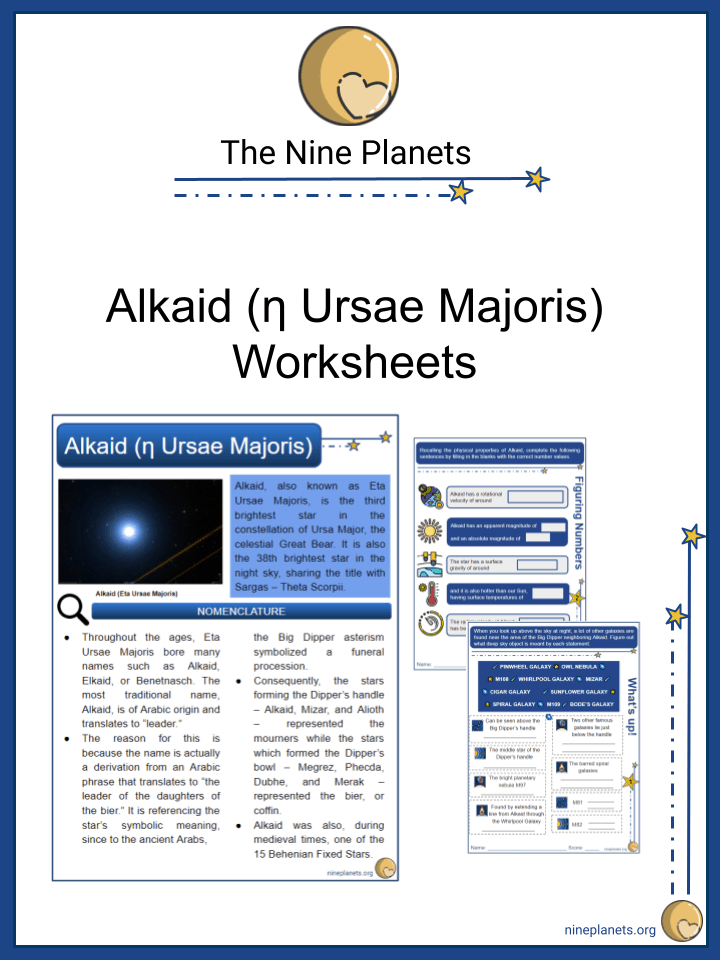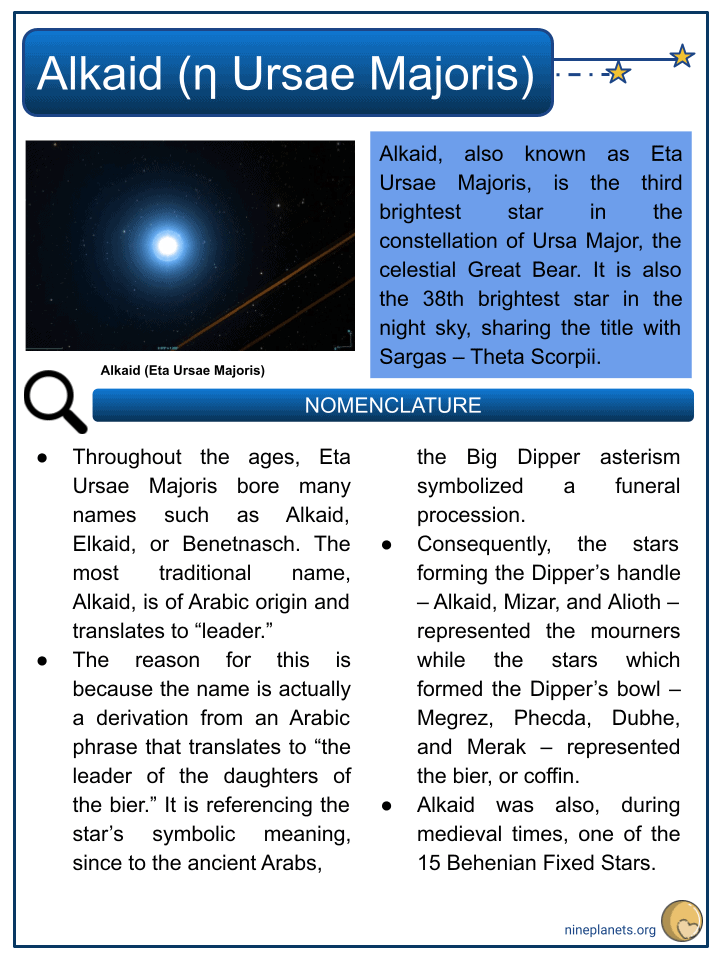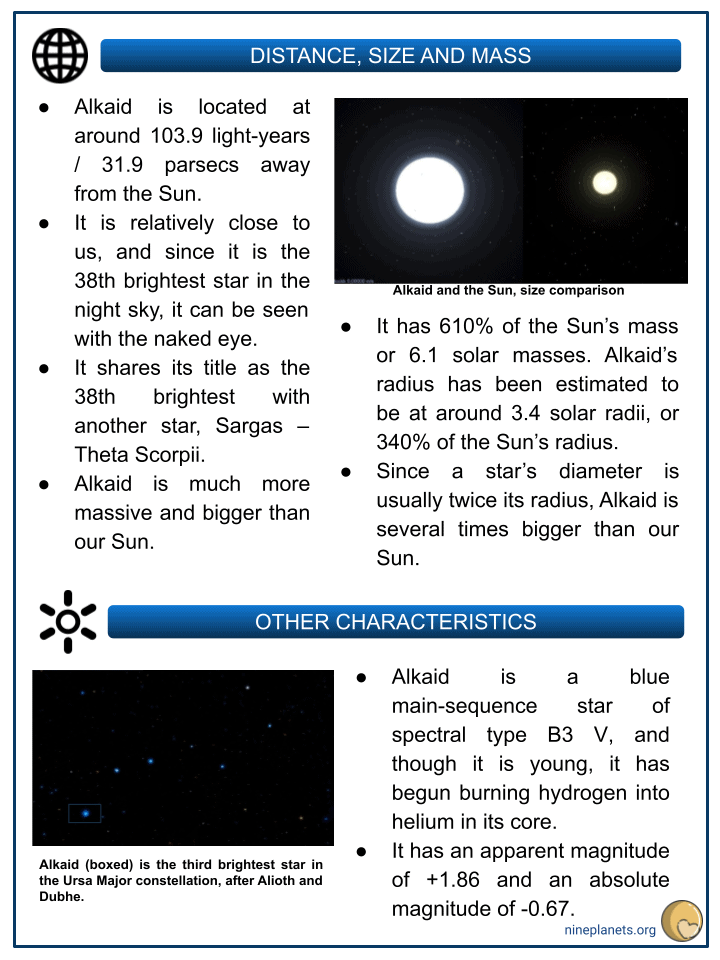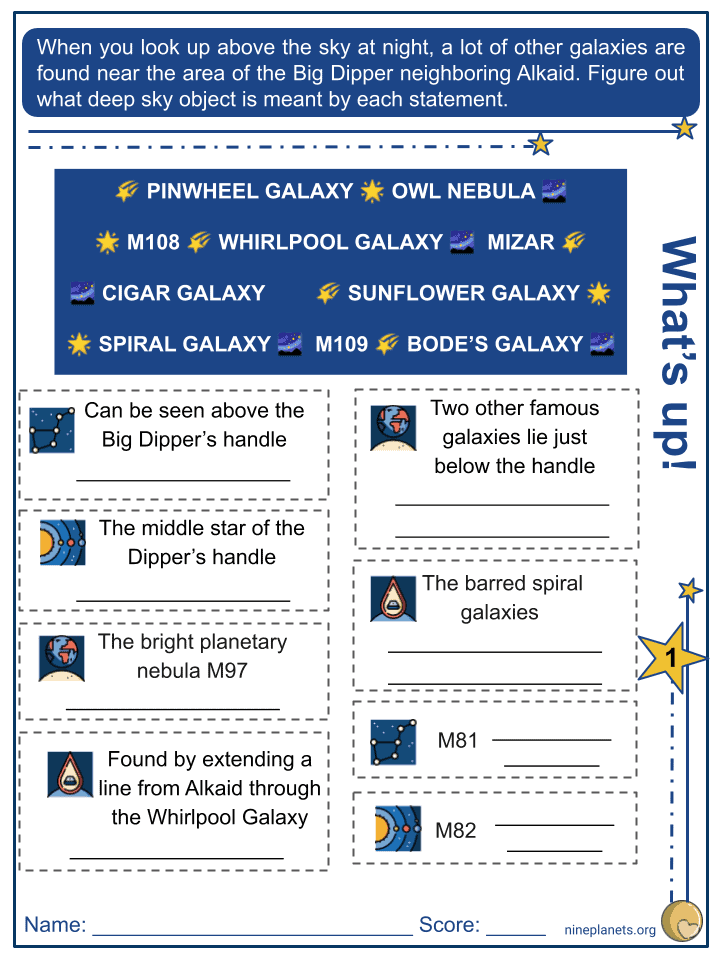Download Alkaid (η Ursae Majoris) Worksheets
Click the button below to get instant access to these premium worksheets for use in the classroom or at a home.

This worksheet can be edited by Premium members using the free Google Slides online software. Click the Edit button above to get started.
Download free sample
Not ready to purchase a subscription yet? Click here to download a FREE sample of this worksheet pack.
Resource Examples
Click any of the example images below to view a larger version.
Key Facts & Information
- Alkaid, also known as Eta Ursae Majoris, is the third brightest star in the constellation of Ursa Major, the celestial Great Bear. It is also the 38th brightest star in the night sky, sharing the title with Sargas – Theta Scorpii.
Nomenclature
- Throughout the ages, Eta Ursae Majoris bore many names such as Alkaid, Elkaid, or Benetnasch. The most traditional name, Alkaid, is of Arabic origin and translates to “leader.”
- The reason for this is because the name is actually a derivation from an Arabic phrase that translates to “the leader of the daughters of the bier.” It is referencing the star’s symbolic meaning, since to the ancient Arabs, the Big Dipper asterism symbolized a funeral procession.
- Consequently, the stars forming the Dipper’s handle – Alkaid, Mizar, and Alioth – represented the mourners while the stars which formed the Dipper’s bowl – Megrez, Phecda, Dubhe, and Merak – represented the bier, or coffin.
- Alkaid was also, during medieval times, one of the 15 Behenian Fixed Stars.
- These stars were believed to have magical properties and were associated with gemstones, plants, or planets.
- The plants or gemstones were used in magic rituals since they represented one of the specific stars and their magical traits, while the planets had other astrological characteristics that were influenced by those stars.
- In the case of Alkaid, it was associated with the Moon and Venus.
- Its gemstone was magnet while the plant that represented it was succory.
Formation
- Most estimates point to Alkaid likely being formed around 10 million years ago, give or take 2.8 million years.
- It is a very young star and in regards to its neighbors in the Big Dipper asterism, it isn’t part of the Ursa Major moving group of stars.
- Thus, its origin is unknown. Alkaid likely formed in a regular molecular cloud of dust and gas.
- Gravity pulled the swirling gas and dust together and resulted in the third brightest star of the Ursa Major constellation, Alkaid.
Distance, Size And Mass
- Alkaid is located at around 103.9 light-years / 31.9 parsecs away from the Sun.
- It is relatively close to us, and since it is the 38th brightest star in the night sky, it can be seen with the naked eye.
- It shares its title as the 38th brightest with another star, Sargas – Theta Scorpii.
- Alkaid is much more massive and bigger than our Sun.
- It has 610% of the Sun’s mass or 6.1 solar masses. Alkaid’s radius has been estimated to be at around 3.4 solar radii, or 340% of the Sun’s radius.
- Since a star’s diameter is usually twice its radius, Alkaid is several times bigger than our Sun.
Other Characteristics
- Alkaid is a blue main-sequence star of spectral type B3 V, and though it is young, it has begun burning hydrogen into helium in its core.
- It has an apparent magnitude of +1.86 and an absolute magnitude of -0.67.
- Alkaid’s spectrum has served since 1943 as one of the stable anchor points by which other stars are classified.
- It is an X-ray emitting star with broadened absorption lines in its spectrum due to its rapid rotation which may be responsible for the presence of a weak disk of material shrugged off of the star.
- Usually, it is speculated that planets may form in these disks of dust, however, Alkaid has been greatly studied and observed and currently, no planets, or any other companions, have been confirmed.
- The star has a rotational velocity of around 150 km / 93.2 mi per second.
- This high velocity does not only contribute to the star’s material expulsion but also distorts the star, giving it an oblate spheroidal shape.
- This usually means that its equatorial radius is bigger than its radius at the poles and it may be possible that there are also temperature variations because of this.
- Some other stars which appear to share this trait are Vega and Achernar.
- Alkaid is a very energetic star, around 594 times brighter than our Sun.
- The star has a surface gravity of around 3.8 cgs and it is also hotter than our Sun, having surface temperatures of around 15,540 K.
- This is around 2.6 times hotter than our Sun. The radial velocity of Alkaid has been estimated to be at around -10.9 km / -6.7 mi per second.
Location
- Alkaid is located in the constellation of Ursa Major, the celestial Great Bear. It is the leftmost star of the Big Dipper’s handle. Alkaid also marks the Great Bear’s celestial tail.
- Alkaid and thus the Ursa Major constellation is circumpolar and can be seen throughout the year to most observers in the northern hemisphere.
- All the months of spring are favorable in observing this constellation.
- Alkaid is located in the vicinity of several bright deep sky objects. The Pinwheel Galaxy (M101) can be seen above the Big Dipper’s handle, forming a triangle with Alkaid and its neighbour Mizar, the middle star of the Dipper’s handle.
- Two other famous galaxies lie just below the handle, in the area between Alkaid and Cor Caroli, the brightest star in the constellation Canes Venatici. These are the Whirlpool Galaxy (M51) and the Sunflower Galaxy (M63).
- The spiral galaxy Messier 94 can also be found in this area, by extending an imaginary line from Alkaid through the Whirlpool Galaxy.
- M94 forms a triangle with Cor Caroli and Chara (Alpha2 and Beta Canum Venaticorum).
Ursa Major
- Ursa Major is the third largest constellation in the sky, after Hydra and Virgo, and the largest of all northern constellations.
- Its size and the familiarity of the Big Dipper asterism make the constellation popular among stargazers, as it is home to many notable deep sky objects.
- In addition to M101, it also contains Bode’s Galaxy (M81), its neighbor the Cigar Galaxy (M82), the barred spiral galaxies M108 and M109, and the bright planetary nebula M97, also known as the Owl Nebula.
The Future
- Most B-type stars, such as Alkaid, have short life spans. The star is expected to burn all of its fuel in less than 100 million years, after which it will start to evolve into a giant star.
- It will later shed its outer layers and become a white dwarf with a mass of around 85% that of the Sun’s mass.
- The 10 brightest stars in Ursa Major are:
- Alioth (Epsilon UMa)
- Dubhe (Alpha UMa)
- Alkaid (Eta UMa)
- Mizar (Zeta UMa)
- Merak (Beta UMa)
- Phecda (Gamma UMa)
- Psi Ursae Majoris
- Tania Australis (Mu UMa)
- Talitha (Iota UMa)
- Theta Ursae Majoris
Did You Know?
- The Chinese knew Alkaid as the Seventh Star of the Northern Dipper – an asterism which corresponds to the western Big Dipper asterism. It was also known as the Star of Twinkling Brilliance.
- Other Asian countries such as Japan and Korea knew Alkaid as Hagusei – the military breaking star – and Mukokseong – most corner star. This suggests that both names originated in ancient China.
- In Hindu mythology, Alkaid was associated with one of the Seven Sages, one of the sons of Brahma, and the grandfather of the deities Asuras and Devas.
- In Chinese fortune-telling, the star is associated with the northern direction – it was believed to be unlucky and thus both hunters and soldiers traditionally avoided pointing their guns in Alkaid’s direction.



